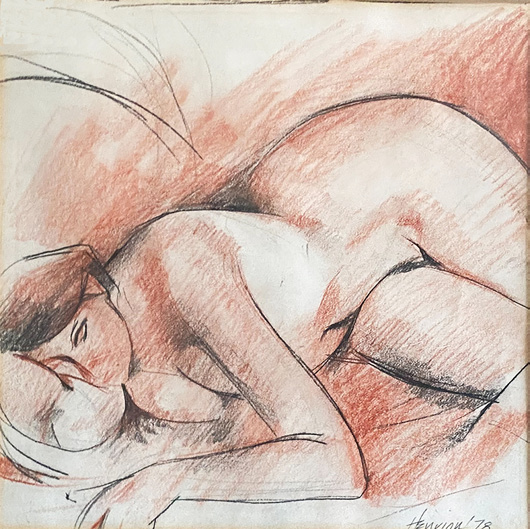
Although Marilyn Henrion lived with her artist husband, Edward, for 64 years, it was only after his death that she discovered some of his most acerbic, satirical art.
Edward Henrion was that rare artist who never sought public approval. In today’s world where artists have press representatives, media accounts, and gallerists eager for publicity, Henrion was quintessentially private. Marilyn Henrion, also an artist, describes him as deeply philosophical, with a keen eye for the hypocracies of his day. She says, “I often had no idea what was in his mind…. He was fond of saying, “All artists should be born with tape over their mouths.”
After her husband died, Marilyn Henrion found a hand-made latched box. Within it, individual drawings were enclosed in a hand-made folder with a cover page, all carefully wrapped in tissue paper. The discovery led to the publication of MICKEY RAT, A NOT-FOR-CHILDREN BOOK. The drawings are characteristic of Henrion’s work —meticulous pen and ink drawings, some with watercolor, mightily inventive and packed with detail. At the end of this sad story, Mickey, a good-for-nothing rat always dressed in tie, jacket and Panama hat, meets up with an angry-faced Angel of Justice who clobbers him. Justice prevails.

Because Henrion did not seek widespread recognition, he had total freedom to comment on the human condition —whether it be politics, art, or literature— in a way that went well beyond what a publication might approve. In the tradition of William Hogarth (1697-1746) and more recently George Grosz (1893-1959) who shamed the shameless with his drawings of Berlin in the twenties and thirties, Henrion had a dark vision and razor-sharp insight of popular culture. His work is as far from a Saturday Evening Post cover as you could imagine. No Norman Rockwell families around the Christmas tree. In fact, Henrion’s marvelous sketch of Santa depicts an old disheveled man, hugely overweight with his pants drooping below his navel. We know this Santa is beyond tipsy by his facial expression and the bottle he grasps with his left hand.
One of Henrion’s most arresting drawings, Stars, depicts three men seated on a bench with stars above their heads. The drawing is enigmatic. What is striking is the stylishness of Henrion’s drawing, the mixture of wildness and control, and the overall atmosphere of tragedy about to erupt.

Sundays with Joe, is a portrait of artist Joseph Cornell (1903-1972) seated in a lounge chair next to a bird feeder. But Cornell is not watching birds. He led a reclusive life caring for his mother and disabled brother. Henrion depicts his old friend immaculately dressed in a green shirt, red tie, and purple jacket. The watercolors are bright and cheerful, but not enough to dispel the dark thoughts that appear to have overcome Cornell.
Henrion was a regular member of the 8th Street Artists Club and was immersed in the art and literary scene of his time. Although many of his contemporaries were abstract expressionists, Henrion preferred working in the figurative tradition. His nude drawings are true to life. Both the fluid, supple men and women’s bodies are lovingly executed, with no hint of the harsh human drama played out in his satirical drawings. The complexity and breadth of his vision is evidenced by this dichotomy.


Originally from Detroit, Michigan, Henrion taught art at Erasmus High School
in Brooklyn for 25 years before retiring in 1987. From his studio in Greenwich Village he created a body of work that spanned from graceful nudes and intimate portraits to satirical drawings that skewered his cultural surroundings as well more broadly, human nature. Henrion’s extensive website ensures that his work will endure and enjoy the proper appreciation it deserves: shop.edwardhenrion. com. All of Henrion’s publications including MICKEY RAT are available on Amazon. G&S
shop.edwardhenrion.com





Leave a Comment